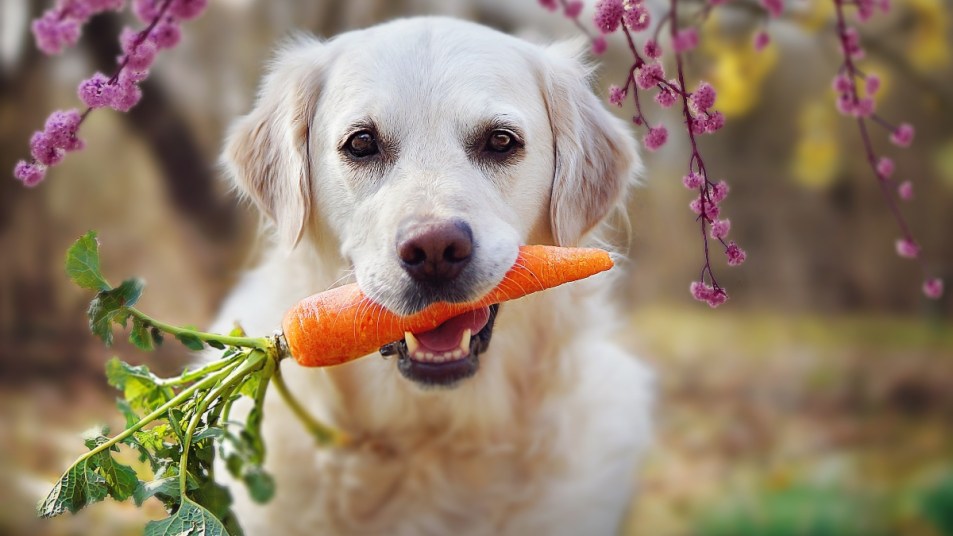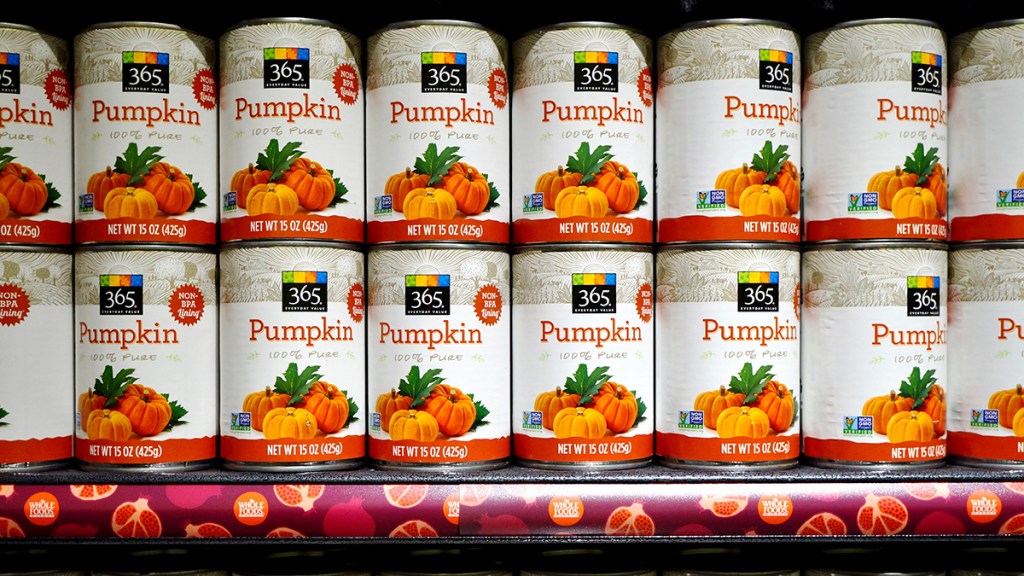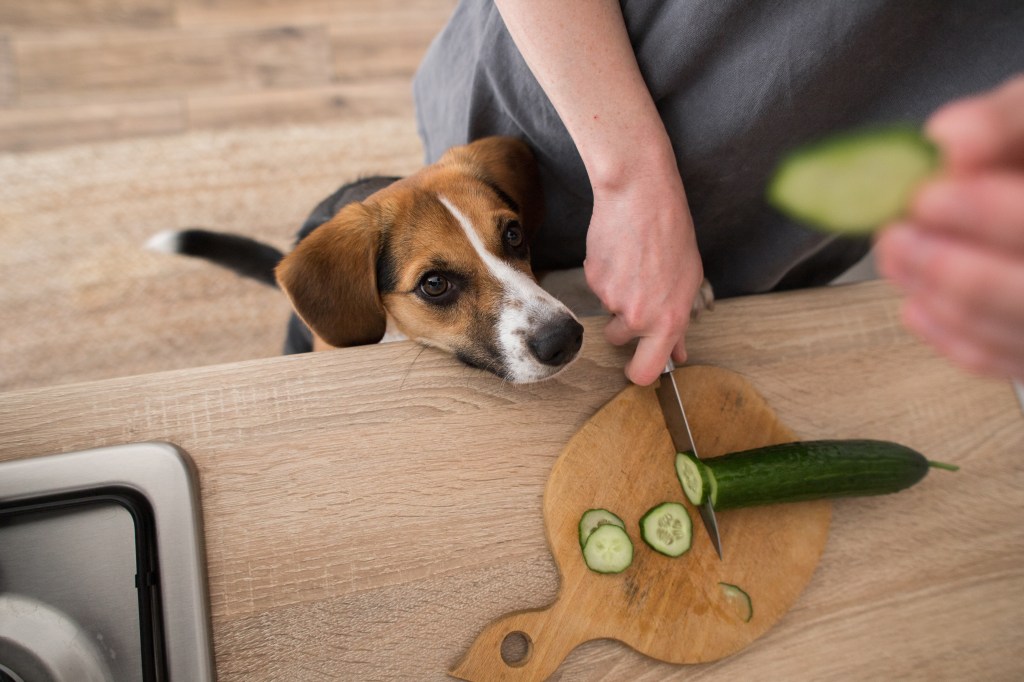Can Dogs Eat Raw Carrots? Vets Reveal the Fruits and Veggies That Are Good for Pups
Plus, foods you absolutely, positively should not let your dog eat

You’re making yourself a yummy salad for lunch. Your beloved pup is, as usual, stationed firmly by your feet to catch any potential falling crumbs. If you were to accidentally drop a bit of carrot and your dog gobbled it up before you could stop him, would that be okay? Can dogs eat raw carrots? Not all fruits and veggies are safe for your dog to consume, but some actually make healthy additions to your dog’s diet. Keep reading to see whether your dog can eat raw carrots, and what plant foods can benefit your furry friend, according to vets and pet experts.
Can dogs eat raw carrots?
Yes, they can. In fact, raw carrots make good dog treats in moderation, according to Dr. Alex Crow, veterinarian and creator of Pet Health Guru. “Munching on raw, crispy carrots can effectively clean your dog’s teeth by acting like a natural toothbrush, removing plaque while providing a tasty snack.” So if Spot’s doggy breath is getting a little too doggy, give him a baby carrot or two.
Carrots also have nutritional benefits for your dog. “These vibrant vegetables are rich in beta-carotene, which the body converts into vitamin A. Vitamin A plays a crucial role in supporting excellent eye health and boosting the immune system,” says Dr. Crow.
Now that you know dogs can raw carrots, keep reading for some other fruits and veggies that are good for your pup.
To support digestion: Pumpkin and sweet potato
These sweet orange treats are more than delicious — they’re great for your dog. Pumpkin is full vitamins, but it’s a superstar when it comes to your pup’s gut. “One of the key advantages of pumpkin is its high fiber content, which can aid in digestion and promote regular bowel movements,” explains Mustafa Tshash, pet behavior specialist and co-founder of How To Pets. “It’s particularly useful for dogs that might be experiencing gastrointestinal issues.” When giving your dog pumpkin, make sure it’s canned, plain and unsweetened — not the pie filling — and only give 1 tablespoon daily for small dogs and 2-3 tablespoons for larger dogs, Tshash advises.

Sweet potatoes are also full of fiber and nutrition. “They are packed with vitamins A, C and B-6, promoting optimal eye health, immune function and nerve function,” says Tshash. Before feeding sweet potatoes to your dog, soak and mash them, and don’t add any flavorings. “Too much sweet potato can cause digestive upset,” advises Tshash, so feed in moderation.
To boost immunity: Blueberries
Blueberries are small but mighty when it comes to their nutritional content, but can dogs eat blueberries? Yes — they’re a great snack you can safely share with your furry best friend. “The abundance of antioxidants helps strengthen the immune system,” says Dr. Crow. “Additionally, vitamins C and K support overall well-being by enhancing bone strength and heart function.” Keep in mind that, because they’re so small, it might be easy to overfeed — but only give as treats in moderation to provide stomach upset. (Click through to read more about dogs and blueberries, plus people foods like dairy and nuts.)
To manage weight: Green beans
If your pup is looking a little fluffier than he should and could stand to lose a few pounds, give him a few green beans to snack on. “Excellent for fiber, manganese, and vitamins A, C and K, green beans can be a healthy choice,” says Dr. Cheri Honnas, veterinary advisor to Bone Voyage Dog Rescue. “I once worked with a dog that needed to lose some weight, and substituting some of his regular kibble with green beans made all the difference,” she adds. A handful of cooked green beans is a good portion — just make sure they’re not salted or seasoned in any way, and cut small enough for your dog to enjoy them safely.
To up hydration: Cucumber

Help your pup stay cool as a cucumber in the heat with, well, cucumber! They’re health for him and help him stay hydrated. “I’m a big fan of cucumbers for dogs in summertime,” says Dr. Linda Simon, a veterinary consultant for dog health site Try Fetched. “They’ve got lots of water [and] they’re full of antioxidants, so they have an anti-inflammatory effect,” she adds. “This is ideal for dogs with chronic medical issues such as atopic dermatitis or arthritis.” Whether your pup is thirsty, dealing with discomfort or just feeling peckish, small bits of cucumber make a great snack.
To increase energy: Peas
Dogs typically get a lot of protein from their kibble. But if you’re looking to give him a little extra protein and energy boost, try mixing in a few peas. “Peas provide protein, fiber and vitamins. They can be a good source of energy and can support your dog’s overall health,” says Tshash. “You can give them fresh or frozen, but avoid canned peas due to the added salt.”
Important things to keep in mind
1. Not all plant foods are safe. There are a lot of fruits and veggies that are good for your dog in moderation, but there are some that are toxic to dogs and must be avoided. Some of these, says Tsash, include raisins, grapes, garlic, onion, avocado and certain types of mushrooms. When in doubt about a food’s safety, look it up or ask your vet. No potential benefit of feeding your dog a plant food is worth the risk.
2. Quantity is quality. Remember that your dog is not a human, and his nutritional needs are different from ours. While fruits and vegetables are good for your dog, they should only compose a small part of her overall diet — “usually around 10% or less,” advises Tshash.
3. Keep an eye on your dog. Just because the food is listed as safe for dogs doesn’t mean it’s safe for your dog. Monitor her reaction to all new foods, including fruits and veggies, to make sure she isn’t allergic. Click here to learn more about what a dog’s allergic reaction looks like and what you can do to help. And make sure whatever you feed her is small enough for her to chew and swallow without choking. (Click through to find out what to do if, heaven forbid, your dog is choking.)
For more advice about feeding your dog, check out these posts:
Never Feed Your Dog These Foods, No Matter How Much They Beg
Veterinarians Weigh in on the Best Dog Food for Your Pet
5 Healthy Pupsicle Treats Your Dog Will Love —and Easy To Whip Up With Minimal Prep
















